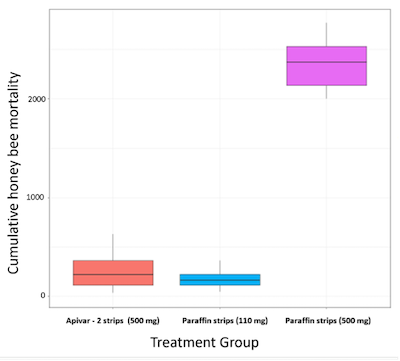 by Véto-pharma
by Véto-pharma The relentless assault of Varroa destructor infestations on honey bee colonies is a global concern, propelling a race towards new pharmaceutical interventions.1 While conventional wisdom often emphasizes medication concentration as the linchpin of treatment success, the reality is far more nuanced.
A myriad of interplaying factors – from pharmacokinetics and pharmacodynamics to the delicate balance of bee and varroa biology – converge to shape treatment outcomes.
Additionally, the potential impacts of increasing medication concentrations on bee health are significant, ranging from immediate effects such as bee mortality to long-term consequences2, including changes to gut microbiota, and cognitive abilities like olfactory learning and memory.3,4 Furthermore, increasing the concentration may result in higher residue levels in bee colonies, which can have serious consequences, including the potential development of resistance to the active ingredient.
Medication concentration, the cornerstone of treatment formulation, defines the potency of pharmaceutical interventions against Varroa destructor infestations.5 However, reaching the optimal concentration levels does not necessarily ensure effectiveness against these infestations.6 Simply boosting medication concentration isn’t the silver bullet either. Unfortunately, this is nevertheless what is regularly observed in the field.
In honey bee colonies, the effectiveness of treatment is influenced by a range of factors including application methods, hive complexities, and bee behaviors.
Recent research by Pohorecka et al. (2021)7 highlighted the complexities of thymol concentration dynamics within honey bee colonies, revealing significant variations based on application methods and environmental factors. These findings underscore the importance of considering different factors in treatment efficacy assessments and formulation strategies. The importance of drug concentration also lies in managing the right balance between efficacy against parasites with the least impact on bee health in the colony ecosystem.
Besides the active ingredient, galenic formulation8 plays a key role in determining the precise release necessary for effectiveness in the target species.9
To illustrate our point, here are two examples of internal studies (conducted by our R&D department), with identical concentrations of active ingredients but different formulations.
Our research and development team conducted these trials as part of a project to reformulate molecules already used in beekeeping, aiming to enhance their effectiveness, speed of action, or mode of application.
Study #1: The trial aimed to compare both concentration and galenic form for a same active ingredient: 110 mg or 220 mg, on tab or plate (see photos below).


The findings suggest a pattern of lower effectiveness in treatments 1 and 2 (tabs) for reducing varroa mites compared to treatments 3 and 4 (plates). This illustrates how the same dosage, but with different formulations, can yield markedly different outcomes. Conversely, doubling the concentration in treatment 4 resulted in lower efficacy compared to treatment 3.
Study #2: Comparison of 3 different acaricide strips, based on the same active ingredient, with the same concentration in each strip.

On this graph, you can see three different acaricide strips based on the same active ingredient, with the exact same dosage. What’s the only change? The global formulation of the strips. You can clearly see improved kinetics in strip C compared to strip A.
Beyond assessing treatment effectiveness, the formulation of a drug significantly impacts bee colonies. One straightforward method to evaluate this impact is by measuring bee mortality post-treatment.
Our R&D team has conducted numerous tests to work on reformulating active ingredients in varroa treatments. For instance, in 2019, we conducted a trial at our R&D apiary in France using 24 colonies, divided into three groups:
Both the colonies treated with Apivar and those treated with paraffin strips at a 500 mg dosage per strip received the same amount of active ingredient. However, the graph shows a significant difference in cumulative honey bee mortality between the Apivar group and the 500 mg Paraffin strips group.

This inconsistency underscores the significance of the drug’s formulation and the manner in which the active ingredients are released within the hive. It illustrates why selecting a treatment solely based on the highest concentration of the active ingredient can be misleading and why mixing homemade treatments can be hazardous, in addition to being forbidden.
Pharmacokinetics and pharmacodynamics10 are critical in understanding how varroa mite treatments function within honey bee colonies and impact bee health.
Pharmacokinetics, the study of how medications are absorbed, distributed, metabolized, and eliminated within both mites and bees, is crucial for developing effective treatment plans that minimize bee harm, reduce residue, and lessen environmental toxicity. Key studies like those by Gregorc et al. (2020)11 highlight the need for treatment plans tailored to bee metabolisms, as formic acid affects worker bees differently from brood. Smart et al. (2023)12 emphasize aligning treatment timing with colony dynamics to optimize efficacy, integrating complex interactions between treatment concentration, pharmacokinetics, and bee biology.
Conversely, pharmacodynamics focuses on action mechanism of a drug while binding targeted receptors. For varroa control drugs, the bees’ biological responses to these drugs is an additional challenge for evaluating treatment efficacy and safety. Research by Nazzi et al. (2022)13 on novel acaricides targeting varroa mites shows promising control strategies by affecting specific biochemical pathways. However, gaps in understanding the action mechanisms of common treatments pose risks of improper dosages and potential treatment failures.
Furthermore, interactions between acaricides and other hive and environment chemicals, such as fungicides, can complicate treatment effects due to synergistic toxicity, as shown in studies highlighting the role of enzyme induction and inhibition in modifying drug effects.14,15,16
Acaricides are crucial for controlling varroa mites but their residues in hive products pose risks to bee health, the quality of hive products, and the environment.17 The key challenge is to balance effective mite control with maintaining the health of honey bees. Residues that accumulate in beeswax, honey, and bee bread pose ongoing risks, affecting bee development, behavior, and overall colony health.18 These residues act as hidden threats within the hive, contributing to the global decline in honey bee populations.19,20
Research has demonstrated that acaricides like tau-fluvalinate, coumaphos, and fenpyroximate, when present in the hive and combined with other substances such as fungicides, can exacerbate toxicity, leading to higher mortality rates among adult worker bees.13, 21
A 2021 study by Benito-Murcia22 shows that residues of tau-fluvalinate in beeswax can lead to the accumulation of active ingredients in the fat bodies of honey bees. Since varroa mites primarily feed on the fat bodies, this could increase their exposure to sublethal dose of the pesticide, potentially enhancing their resistance to it.
This finding underscores the importance of selecting active ingredients carefully and developing new varroa treatments that consider the impact of residue accumulation.
Additionally, beekeepers can mitigate these effects by regularly replacing their brood combs.
Pharmaceutical companies are tasked with developing sustainable treatments for varroa mites, but beekeepers also play an essential role in keeping bee colonies below the damage thresholds caused by these mites. We encourage you to actively manage varroa through an integrated pest management (IPM) approach that incorporates mechanical, biological, and carefully chosen chemical interventions.1,23
Regular counting of varroa mite infestations, employing exclusively approved treatments, incorporating biotechnical approaches like colony splitting and drone brood removal, regularly replacement of brood combs, and continuously working to maintain low varroa levels throughout the season are fundamental strategies. These proactive steps significantly influence the vitality and productivity of bee colonies, safeguarding their welfare and output.
 by Ulrike Marsky
by Ulrike Marsky  by Véto-pharma
by Véto-pharma References:
1 Cameron J Jack, James D Ellis, Integrated Pest Management Control of Varroa destructor (Acari: Varroidae), the Most Damaging Pest of (Apis mellifera L. (Hymenoptera: Apidae)) Colonies, Journal of Insect Science, Volume 21, Issue 5, September 2021, 6, https://doi.org/10.1093/jisesa/ieab058
2 Bahreini R, Nasr M, Docherty C, de Herdt O, Muirhead S, Feindel D. Evaluation of potential miticide toxicity to Varroa destructor and honey bees, Apis mellifera, under laboratory conditions. Sci Rep. 2020 Dec 9;10(1):21529. doi: 10.1038/s41598-020-78561-2. PMID: 33299084; PMCID: PMC7726572.
3 Motta EVS, Mak M, De Jong TK, Powell JE, O’Donnell A, Suhr KJ, Riddington IM, Moran NA. Oral or Topical Exposure to Glyphosate in Herbicide Formulation Impacts the Gut Microbiota and Survival Rates of Honey Bees. Appl Environ Microbiol. 2020 Sep 1;86(18):e01150-20. doi: 10.1128/AEM.01150-20. PMID: 32651208; PMCID: PMC7480383.
4 Sandoz JC. Behavioral and neurophysiological study of olfactory perception and learning in honeybees. Front Syst Neurosci. 2011 Dec 8;5:98. doi: 10.3389/fnsys.2011.00098. PMID: 22163215; PMCID: PMC3233682.
5 Pharmacology: Principles and Practice ©2009, Elsevier.
6 Underwood, Robyn & Currie, Rob. (2006). Effect of Concentration and Exposure Time on Treatment Efficacy Against Varroa Mites (Acari: Varroidae) During Indoor Winter Fumigation of Honey Bees (Hymenoptera: Apidae) with Formic Acid. Journal of economic entomology. 98. 1802-9. 10.1603/0022-0493-98.6.1802.
7 Pohorecka, K., et al. (2021). Dynamics of thymol concentration in honeybee colonies and its impact on Varroa control. Journal of Economic Entomology, 114(3), 1380-1387.
8 Galenics is the process that turns an active ingredient into a ready-to-use medicine that can be dosed as required. Galenic formulation deals with the principles of preparing and compounding medicines in order to optimize their absorption and forms part of pharmaceutics, the discipline (or science) of dosage form design.
9 Salkova D, Gurgulova K, Zhelyazkova I (2024): Clinical trial of the efficiency of three different compositions of acaricidal substances against varoosis in honey bee colonies. Ankara Univ Vet Fak Derg, 71 (2), 157‐163. DOI: 10.33988/auvfd.1033097.
10 Basic Pharmacokinetics and Pharmacodynamics: An Integrated Textbook and Computer Simulations, Second Edition. Edited by Sara E. Rosenbaum. ©2017 John Wiley & Sons, Inc. Published 2017 by John Wiley & Sons, Inc.
11 Gregorc, A., et al. (2020). Comparative pharmacokinetics of formic acid in worker bees and brood. Journal of Apicultural Science, 64(2), 137-145.
12 Smart, M., et al. (2023). Integrating medication strategies with bee physiology for effective Varroa control. Journal of Apicultural Research, 62(1), 45-52.
13 Nazzi, F., et al. (2022). Novel acaricides targeting Varroa mites: Mechanisms of action and implications for honeybee health. Pest Management Science, 78(1), 82-91.
14 Biddinger, D. J., et al. (2013). Comparative toxicities and synergism of apple orchard pesticides to Apis mellifera (L.) and Osmia cornifrons (Radoszkowski). PloS one, 8(9), e72587.
15 Iwasa, T., et al. (2004). Mechanism for the differential toxicity of neonicotinoid insecticides in the honey bee, Apis mellifera. Crop Protection, 23(5), 371-378.
16 Johnson, R. M., et al. (2013). Acaricide, fungicide and drug interactions in honey bees (Apis mellifera). PloS one, 8(1), e54092.
17 Blacquière T., Smagghe G., van Gestel C.A., et al. (2012). Neonicotinoids in bees: a review on concentrations, side-effects and risk assessment. Ecotoxicology, 21(4): 973-992.
18 Thompson H.M., Brown M.A., Ball R.F., et al. (2014). An investigation into the detection of pesticide residues in beeswax samples sourced from honey bee colonies (Apis mellifera) in England. Pest Management Science, 70(8): 1255-1262.
19 Apiculture.net (2015). Les néonicotinoïdes, ces insecticides tueurs d’abeilles. Available at: https://www.apiculture.net/blog/tout-savoir-sur-les-neonicotinoides-ces-insecticides-tueurs-dabeilles-n137
20 Reporterre (2017). L’autorisation de deux insecticides « tueurs d’abeilles » indigne les apiculteurs. Available at: https://reporterre.net/L-autorisation-de-deux-insecticides-tueurs-d-abeilles-indigne-les-apiculteurs
21 Johnson, R. M., et al. (2013). Acaricide, fungicide and drug interactions in honey bees (Apis mellifera). PloS one, 8(1), e54092.
22 Benito-Murcia, María, et al. “Residual tau-fluvalinate in honey bee colonies is coupled with evidence for selection for Varroa destructor resistance to pyrethroids.” Insects 12.8 (2021): 731.
23 https://www.epa.gov/safepestcontrol/integrated-pest-management-ipm-principles
Join the Véto-pharma community and receive our quarterly newsletter as well as our occasional beekeeping news. You can unsubscribe at any time if our content does not suit you, and your data will never be transferred to a third party!
© 2019-2025, Véto-pharma. All rights reserved